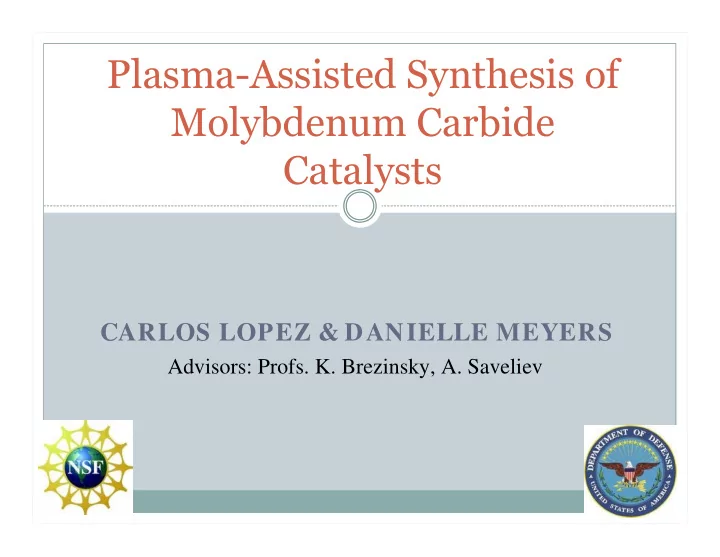

Plasma-Assisted Synthesis of Molybdenum Carbide Catalysts CARLOS LOPEZ & DANIELLE MEYERS Advisors: Profs. K. Brezinsky, A. Saveliev
Overview •Motivation •Hypothesis •Experimental Methods •Results •Conclusions •Future Work
Background: Motivation •Noble metal character •Water-gas shift reaction •PEM Fuel Cells •Non-thermal Plasma •Fourth state of matter •Parameters •Advantages
Why do we want to replace noble metals? 1 gram 10 %‘Platinum on carbon’ catalyst = $39 1 gram Molybdenum metal = $0.39 Disclaimer: Does not include diamonds
Hypothesis •Plasma synthesized, nanostructured molybdenum carbide is more active than commercial catalysts
Synthesis Apparatus Top Chamber Argon Electrostatic Particle Suspension Ethylene Bottom Chamber Plasma and molybdenum carbide formation Vacuum: Low Pressure
What happens in the plasma? Argon Mo C 2 H 4 H· H· Mo e- C· Ar+ Ar+ e- H· H· C· H· Mo Mo H· Ar+ e- Ar+ C· H· C· Mo Ar+ e- Ar+ H· H· Mo 2 C
Product Collection Polycarbonate Filter Metal Mesh Filters Washers
Characterization Transmission Electron Microscopy • Atomic resolution • Crystallography
TEM Preparation To grind, or not to grind, that is the question…
Electron Microscopy Image Simulation
Catalytic Activity + ⎯ ⎯ → ⎯ + catalyst CO H O CO H 2 2 2 � Water-gas shift � PFR � Comparison � CuO/ZnO � MoC bulk
Catalytic Reactor Coalescence and Condenser Filters Deionized Water Flow Gas Chromatograph Packed Catalyst
Characterization: TEM Results 20 cc/min ethylene Molybdenum metal Comparable magnification � No film Mo 2 C Mo metal
Electron Microscopy Image Simulation 20 cc/min ground Orthorhombic Structure *Low, Ke-Bin 2008
EMIS continued… Molybdenum Metal (ground) Hexagonal Structure
Catalysis Troubleshooting � Leaks � Coalescence Filter
Catalytic Activity: CO (g) consumed 2000 1800 1600 1400 GC Peak Area 1200 of CO 1000 (mV*sec) 800 600 400 200 0 20 cc Commercial MoC Bulk Control Catalyst Species
Conclusions and Future Work � Activation/Reduction � Surface Composition Analysis � Investigate Plasma Parameters
Acknowledgments � National Science Foundation, REU Program � Department of Defense � Professor Kenneth Brezinsky � Dr. Alexei Saveliev � Abby Saddawi: Graduate Research Advisor/Rock Star � Dr. Ke-Bin Low and Dr. Alan Nicholls
References Low, Ke-Bin. Crystallography Modeling (2008) � Xiao, Tiancun, et al. Study of the Preparation and Catalytic Performace of Molybdenum � Carbide Catalysts Prepared with C2H2/H2 Carburizing Mixture. Journal of Catalysis, 211, pp 183-191 (2002) Claridge, John B. et al. New Catalysts for the Conversion of Methane to Synthesis Gas: � Molybdenum and Tungsten Carbide. Journal of Catalysis. 180, pp 85-100 (1998). Bouchy, Christophe. Et al. A new route to the metastable FCC molybdenum carbide α - � MoC 1-x . Chem Comm, 16 Dec 1999. Choi, Jae Soon. Et al. Influence of the Degree of Carburization on the Denisty of Sites � and Hydrogenating Activity of Molybdenum Carbides. Journal of Catalysis. 193, pp 238-247 (2000). Fridman, Alexander and Kennedy, Lawrence A. ‘Plasma Physics and Engineering’, 2004, � New York, Taylor and Francis Books, Inc. Patt, Jeremy, et al. Molybdenum carbide catalysts for water-gas shift. Catalysis Letters, � 65, pp 193-195 (2000)
Recommend
More recommend